KCRW’s acclaimed music documentary podcast, Lost Notes, returns for its fourth season. Co-hosts Novena Carmel (KCRW) and Michael Barnes (KCRW / KPFK / Artform Radio) guide you through eight wildly different and deeply human stories, each set against the kaleidoscopic backdrop of LA’s soul and R&B scene of the 1950s-1970s. Support KCRW’s original programming like Lost Notes by donating or becoming a member.
Lost Notes introduces you to the Mizell Brothers: one (Fonce) wrote hits for Motown, while the other (Larry) worked on the Apollo mission. From their secret home studio in the Hollywood hills, they created a unique sound that jazz purists hated, but which strongly influenced the sounds of decades to come. We explore how LA itself served as the inspiration for their greatest work with artists like Donald Byrd, A Taste of Honey, and Johnny Hammond.
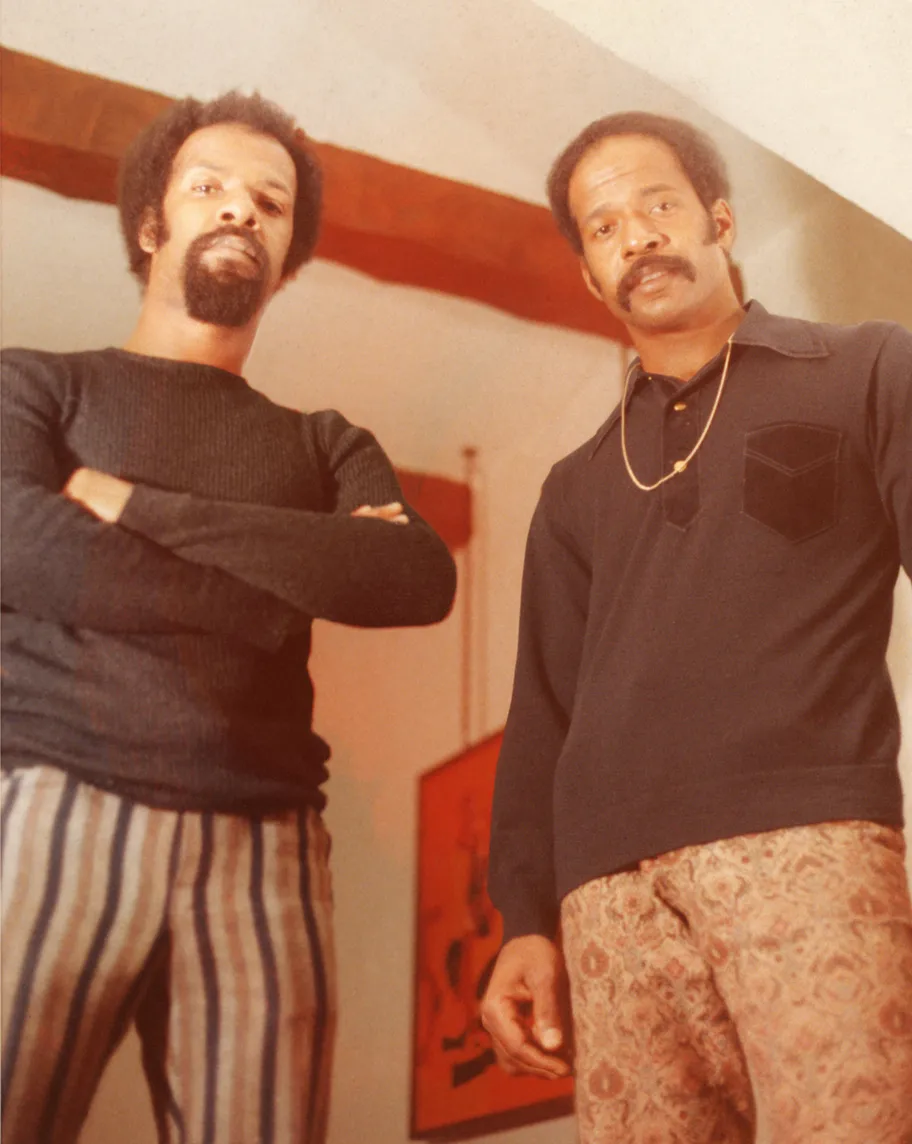
The Mizell Brothers: Larry (R) and Fonce (L). (Photo by Dan Bolling)
Michael Barnes
Alphonso and Laurence Mizell - also known as Fonce and Larry - spent their early years in the Sugar Hill neighborhood of Harlem. They lived just up the hill from Harlem River Drive on Edgecombe Avenue – a street which once counted Thurgood Marshall, W.E.B. DuBois, Count Basie, and Benny Carter among its residents.
Novena Carmel
When Larry and Fonce were in middle school, the family moved from Harlem to Englewood, New Jersey. There they met Freddie Perren: an aspiring musician who was close to Fonce’s age. Freddie, Fonce, and Larry went on to attend Dwight Morrow High School, where they were mentored by the school's band director, Thaddeus Kropczynski. Thaddeus arranged for Larry and Fonce to rent trumpets for a few bucks a week so they could play in the band.
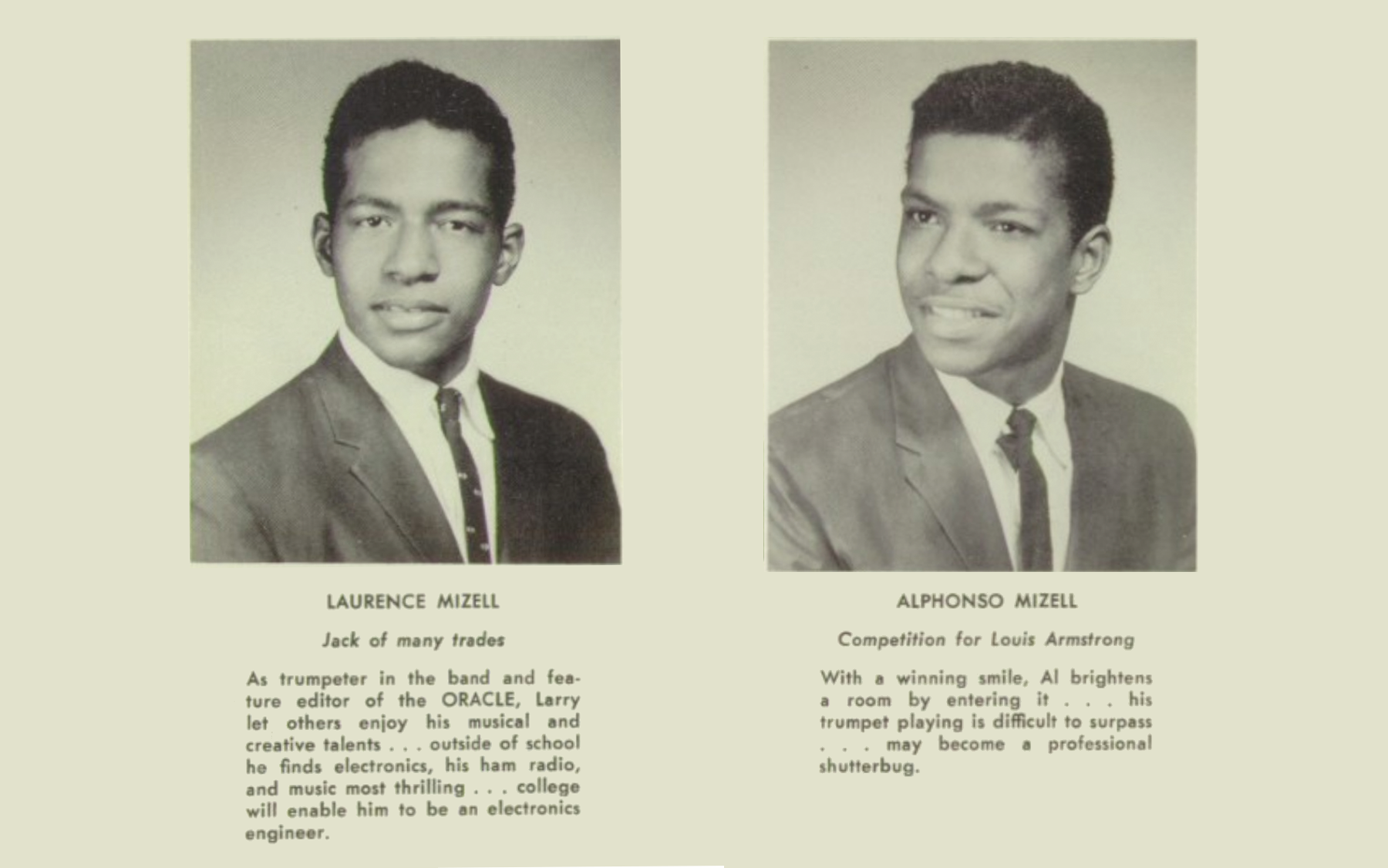
Larry and Fonce Mizell’s senior portraits from Dwight Morrow High School in 1961. (Image via Dwight Morrow High School)
Michael Barnes
Back home, they shared a duplex with their parents and their younger brother, Rodney. Their grandparents lived in the unit next door where they had an upright piano, which their grandmother could play by ear – although really only the black keys. The boys’ enduring fascination with the instrument eventually led their mom to rent a baby grand piano of their own. In school, they had an ensemble called the Jazz Pipers, which included Freddie Perren – and also their French teacher, who would sometimes sit in to recite poetry over their music. They also sang in doo-wop groups, including one called the Nikons. And while there aren’t any recordings from this period of time, if you fast-forward to the 1970s, it’s clear that doo-wop had a major influence on the ways that Larry, Fonce & Freddie harmonized and sang on many of their classic 1970s records.
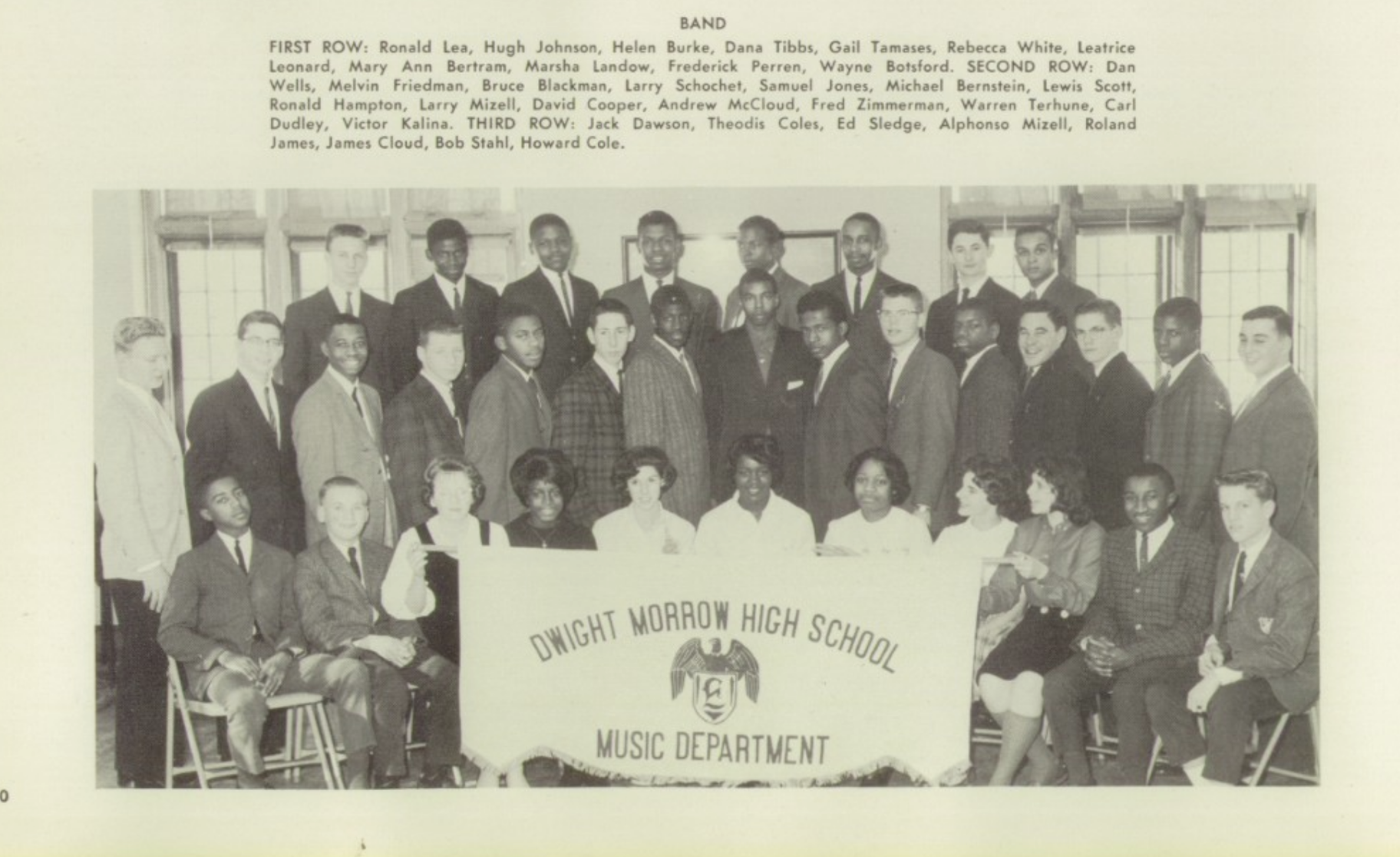
The Dwight Morrow High School band in 1961, including Larry and Fonce Mizell and Freddie Perren. (Image via Dwight Morrow High School)
Novena Carmel
And one memory from their time growing up in Jersey stuck in Larry’s mind: He had a part-time job in high school. And one day, his boss took him out for a spin in his Porsche 356 sports car. Larry remembered the incredible handling of that car, and how it could make 90-degree turns on a dime. It left him with a feeling he couldn’t quite put his finger on … but it was one that would come back to him years later.
Michael Barnes
That is such a beautiful memory, although I doubt all of their memories growing up in Englewood, New Jersey during this time were as sweet. Fonce, Freddie, and Larry graduated from Morrow High in 1961 – the same year that a lawsuit was filed by several Black families against the Englewood Board of Education, accusing them of a combination of deliberate and ‘de facto’ segregation in the city’s schools. You have to remember…this was only seven years after the landmark Brown v. Board of Education decision. Many places in the US – and Englewood in particular – were not prioritizing efforts around school desegregation.
Novena Carmel
Yeah. And one can imagine how the boys handled the transition from a predominantly Black neighborhood like Sugar Hill to a city with Englewood’s integration problems. And it might also explain why Fonce, Freddie, and Larry chose to enroll at Howard University – one of the country's largest and most preeminent Historically Black Colleges and Universities.
Michael Barnes
Upon arriving at Howard that fall in 1961, they heard about the university’s homecoming talent show, which was rumored to be the hottest event on campus. So they put together a vocal quartet called the Vanlords with their friend John Butler. Despite the fact that they were only freshmen, they won the show, making them instant stars around campus. And they went on to clean house at other talent shows around town as well.
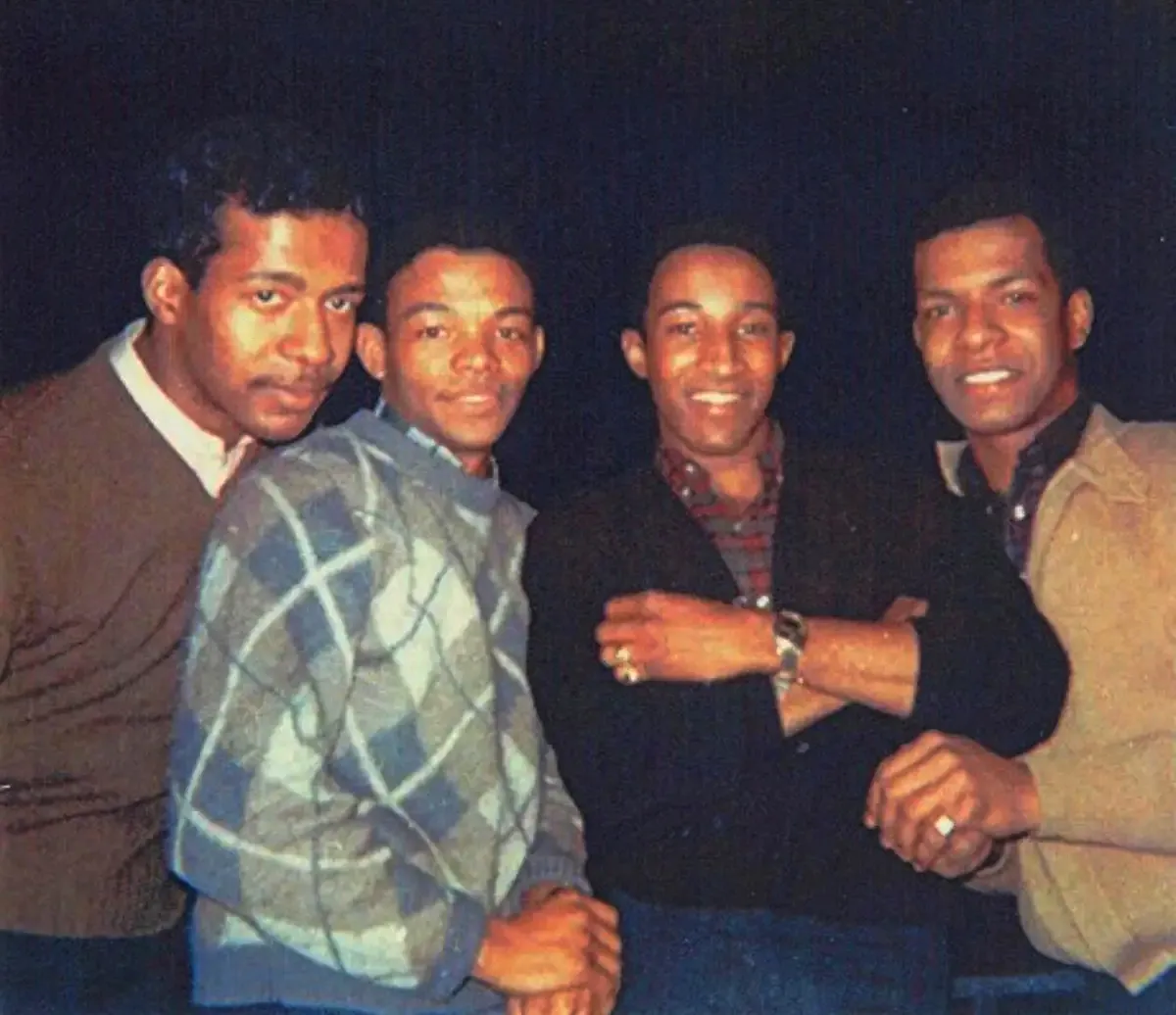
The Vanlords (L-R: Larry Mizell, John Butler, Freddie Perren, Fonce Mizell). (Courtesy Larry Mizell)
Novena Carmel
A few years later, in 1964, they came across a freshman "playing his butt off,” as Larry says, on a piano in the rehearsal rooms. He turned out to be Donny Hathaway, a kid from St. Louis who was studying music at Howard on a fine arts scholarship. Donny became an honorary member of the Vanlords, sitting in with them at shows on occasion – although he wouldn’t stick around to finish his degree before his own career came calling.
Michael Barnes
Now that the Mizells & Freddie Perren had a successful group, they figured the next step was to start their own record label. Larry came up with the name Hog Records, after a slang term for a Cadillac. Fonce found three singers from nearby Morgan State University in Baltimore, whom they named The Moments. They booked the group into Edgewood Studios in Washington, DC, at a cost of about $25 – or $250 in today’s money. A few Howard undergrads came onboard as the backing band, along with some string players from the Air Force Band, and also a few Alpha Kappa Alpha sorority girls on backing vocals.
The Moments, “Baby I Want You”
Novena Carmel
But the trouble was, they had no idea how to market the record … so the Mizells ended up sitting on a pile of copies of records they couldn't sell. Eventually, kind of like “Tainted Love,” the song found an audience in those all-nighters of the Northern Soul scene, and now those 45s fetch a pretty penny. Larry has even said how much he wished he held on to more of them!
Michael Barnes
I’ll bet!
Novena Carmel
Yeah. But this first experience recording in a studio environment absolutely captivated the brothers. And from that experience, Larry and Fonce decided they were better suited to writing and production, rather than running a record label.
Michael Barnes
Now, as you might expect, Fonce and Freddie were enrolled in the Music Department at Howard. But Larry was working toward his Bachelors in Engineering. Like so many other young folks of the time, he was fascinated by the space program — but unlike many of those folks, Larry actually had the talent and the training to turn it into a career. After graduation, he decided that he wanted to work on the cutting edge of the aerospace industry. He got an interview at Grumman Aerospace on Long Island, the company that held the contract with NASA to build the Apollo Lunar Module.
Novena Carmel
And while Larry was waiting in Grumman’s lobby for an interview, he ran into the head of the Microelectronics division, Edward Keonjian. After talking with Larry for a few minutes, Keonjian invited him to apply to his division instead, and hired him almost immediately. And from there, Larry worked on the Lunar Module while pursuing his Masters in Engineering at NYU. On the weekends, though, he shed his suit and tie and settled into a more familiar role, playing in three or four bands around town.
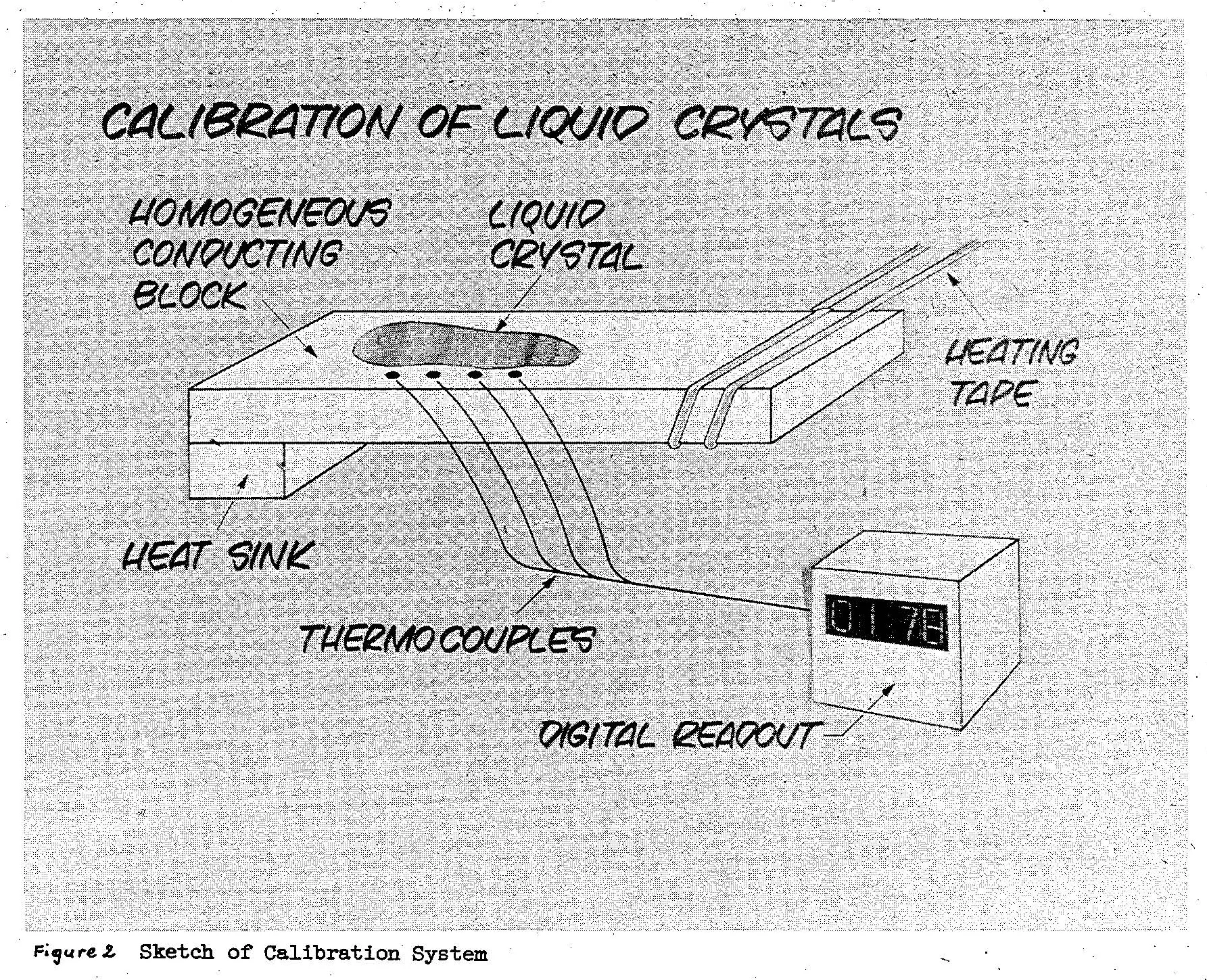
Illustration from a 1971 research paper on liquid crystals by Larry Mizell. The full paper is downloadable below. (Courtesy Larry Mizell)
Michael Barnes
And while Larry was off literally working on rockets, Fonce was finishing up his Fine Arts degree at Howard. Jazz trumpet player Donald Byrd arrived at Howard in 1968 to establish their Jazz Studies program. Fonce was one of Byrd's earliest students, and Larry would also come down from time to time to attend Byrd's lectures. Larry recalls that Byrd wasn't that focused on teaching the music theory side of things -- he was more interested in teaching these kids about the practicalities of being a successful working musician out in the world. And from their time in class together, Fonce and Byrd established a relationship that would serve them both well in the coming years.
Novena Carmel
After graduating in June of 1969, one of Fonce's professors told him about a relative out in LA who was starting a new label called the Los Angeles Recording Company, or LARCO. Freddie Perren had already moved out that way trying to catch a break, so Fonce decided to pack up and join him. Donald Byrd got word that Fonce was heading to LA, so he put in a call with Deke Richards. Deke was an expat from Detroit who had moved to LA to work with Motown in their new West Coast office. He invited Fonce and Freddie to the Motown offices for a meeting … and they were canny enough to bring Deke a demo tape with a few of their songs. That tape very quickly made its way to Berry Gordy.
Michael Barnes
At that time, Gordy was still smarting from his legal battle with Holland-Dozier-Holland, the hitmaking team who penned a long list of Motown classics before breaking ranks with the company in 1967. Gordy was now very wary of any more of what he called “back room superstars” joining the company. So, in 1969, he created a new entity called The Corporation, who would write and produce anonymously on Motown's behalf. Deke Richards was the creative director of the Corporation, and he invited Fonce and Freddie to become part of the team. Rounding out the Corporation was Berry Gordy himself.
Novena Carmel
The new group's first assignment was a song for Gladys Knight called "I Wanna Be Free.” But the night before the recording, Gordy called and said that he was changing the assignment. Instead of Gladys, the song would be recorded by a new family group from Gary, Indiana. He told the Corporation to come up with a different lyrical concept, and to change the key to something more suited to young men's voices. Fonce and Freddie were disappointed about missing out on Gladys Knight for a bunch of kids, but they showed up at the studio the next day with the revised number, which was now called "I Want You Back.”
The Jackson 5, “I Want You Back”
Michael Barnes
Recorded in August of 1969, “I Want You Back” went on to become the first of four consecutive #1 singles by the Jackson Five – the next two of which, "ABC" and "The Love You Save," were also written by the Corporation. And suddenly, Fonce and Freddie were already at the center of Motown’s hit-making machine.
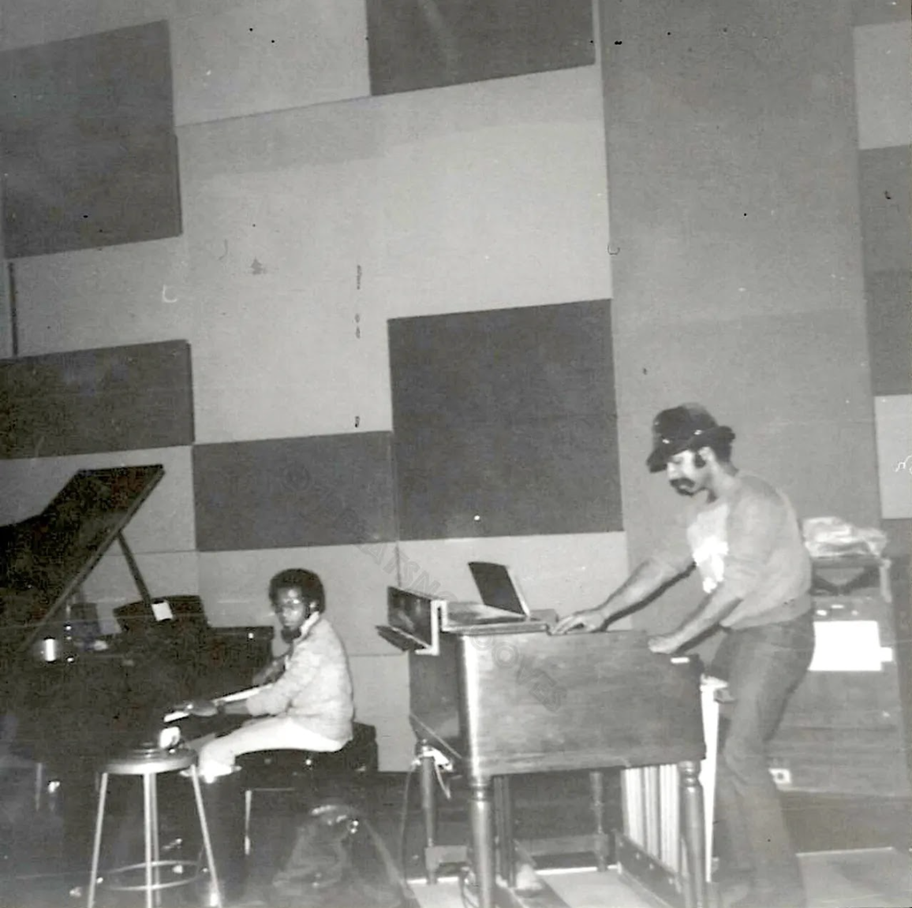 Fonce Mizell and Freddie Perren at Motown’s LA studios. (Courtesy of Freddie Perren Beats and Grooves Inc. / FreddiePerren.com)
Fonce Mizell and Freddie Perren at Motown’s LA studios. (Courtesy of Freddie Perren Beats and Grooves Inc. / FreddiePerren.com)
Novena Carmel
Meanwhile, as the ‘60s moved into the ‘70s, Larry was enjoying his success at Grumman, traveling to Europe for conferences and publishing his own research. But he was feeling called back to the music – especially after hearing about Fonce and Freddie’s massive success at Motown. And Fonce was constantly asking him to come out and join them in LA. So, once he finished his Masters Degree at NYU, Larry gave his notice at Grumman and answered his brother's call at last.
Michael Barnes
Just as Larry arrived, Fonce’s work with Motown and the Corporation was winding down. By 1972, none of the Jackson Five’s recent hits had been written by the team. Hal Davis, who was head of Motown’s West Coast operation, had taken over as the Jackson Five’s new producer-in-chief.
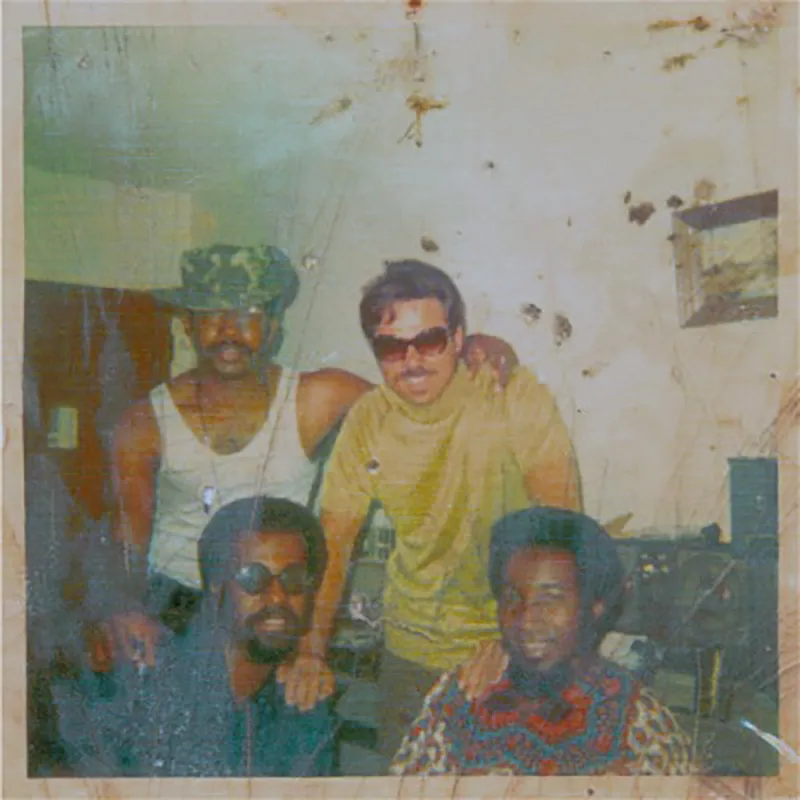
Larry Mizell and Deke Richards (top) with Fonce Mizell and Freddie Perren (bottom). (Courtesy of Larry Mizell)
Novena Carmel
And this gave the space for the brothers to get back together again as a working unit outside the Corporation. Fonce and Larry scored their first Motown credit by getting a song placed on the Jackson Five’s seventh album, Skywriter. And shortly thereafter, in the summer of 1972, Motown came calling on behalf of another major artist.
Marvin Gaye, “Inner City Blues”
Michael Barnes
Marvin Gaye was feeling creatively restless after the massive success of What's Going On. He’d been working on scattered sessions in LA and Detroit, but nothing was taking shape. So, in order to help things along, the label invited other producers in the Motown family to submit tracks for Marvin’s consideration – including the Mizells.
Novena Carmel
The brothers sent in three songs to Motown – and, in the end, all three were selected. Marvin and the Mizells got together in the studio in July of 1972 … but only two of the three songs were finished before Marvin abandoned the project to turn his attention to the soundtrack for the movie "Trouble Man."
Michael Barnes
The two tracks they did complete were called “Where Are We Going?” and “Woman of the World.” And although these tracks circulated on bootlegs for decades, they weren’t released commercially until the 21st century. But thank goodness we didn’t lose these recordings to time, because they are amazing, and surely would have been hits if released at that time.
Marvin Gaye, “Where Are We Going?”
Novena Carmel
This may have been the last straw for Larry and Fonce, as far as Motown was concerned. Between feeling squeezed out of the Jackson Five and being left high and dry on the Marvin project, it seemed like it was time for them to take more control over their creative work.
Michael Barnes
That opportunity would come sooner than they might have expected. As it happens, just a few months earlier, the brothers had gotten a call from their old mentor, Donald Byrd, who was looking for a new sound. Larry and Fonce then worked up a pair of tracks with Byrd as part of a planned collaboration: “Flight Time” and “Mr. Thomas.” But it had been radio silence since then. However, just as the Motown situation was winding down, Byrd called back with good news: His label, Blue Note, had finally cleared them to resume work on the album.
Novena Carmel
And that record would become the Mizells’ first opportunity to really stretch out and show what they could do. Byrd’s previous album, “Ethiopian Knights,” was a fusion effort that ventured into hard funk and atmospheric grooves. But for this new record, he handed over the creative keys entirely to the Mizell Brothers. It was a gesture of absolute confidence on the part of their former mentor, and really gave them the chance to truly take flight.
Donald Byrd, “Flight Time”
Michael Barnes
And as all this is happening, arguably at the exact perfect moment, they found their own little slice of paradise in Los Angeles. In June of 1972, the brothers found a three-bedroom property up a private drive in the Hollywood Hills, with a street address right on Hollywood Boulevard. Like most of the homes in the neighborhood, it was a split-level house built right into the hill.
Novena Carmel
The lower deck overlooked a swimming pool to open out over the canyon, revealing a picture-perfect panoramic view of the city, trailing off to Santa Monica in the distance. At night, as LA's giant grid of lights blinked on after dusk, the cars on La Cienega Boulevard made a perfect seam of light down the middle. The brothers suddenly had an almost mythical view of Los Angeles right out their backyard. And what they really wanted was for the house to become their sanctuary: a place where they could rise above LA's easy distractions and get back to basics making music together. So they turned the bedroom off the deck into their jam studio. Every inch of it was packed with instruments: a drum set, guitars, bass guitars, a piano, and an array of synthesizers.
Michael Barnes
And from there, the Mizells passed their days riding high on pure inspiration. They'd get together and jam, picking up instruments at random, playing off one another -- with a Sony tape recorder always running, in case they stumbled across the perfect riff or melody. On any given day, one of them might get a chord progression stuck in their head and jump into the studio, and the other might hear it from some distant part of the house and be drawn into the room by what they were hearing.
Novena Carmel
And this wasn’t a party house or a bachelor pad. They didn’t even have group jam sessions. The house was strictly devoted to the musical synergy that the Mizells shared. And that was true whether they were writing for a specific project, or just playing for pleasure. It was an auspicious place to begin writing and working out this new Donald Byrd album – which would eventually be called Black Byrd.
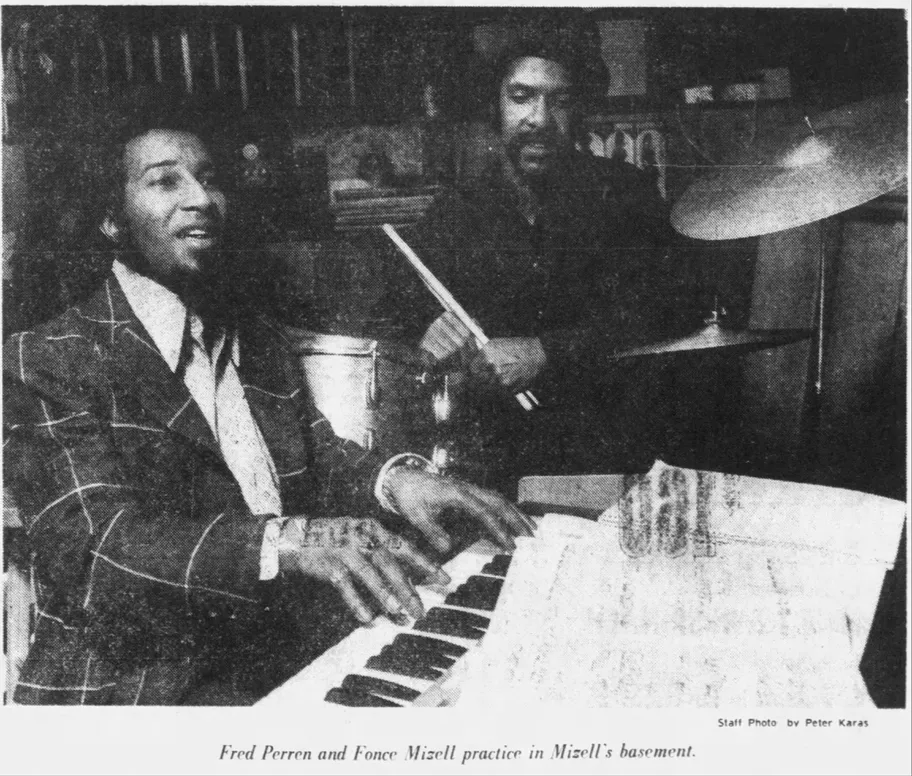
Freddie Perren and Fonce Mizell in the Mizell brothers’ home studio, December 1973. (Courtesy of Freddie Perren Beats and Grooves Inc. / FreddiePerren.com)
Michael Barnes
And now that Larry was living in a city with such a vibrant car culture, an old memory came flooding back to him: He thought of that high-school boss, and the thrill of riding in his Porsche 356. And now that both brothers had the means, they bought their own pair of sweet black Porsche 911S convertibles – which were indeed perfect for handling those tight, narrow turns up in the Hills. It was the fulfillment of a youthful dream … and when we talked to Larry about this time, he remembers feeling absolute gratitude for what they achieved.
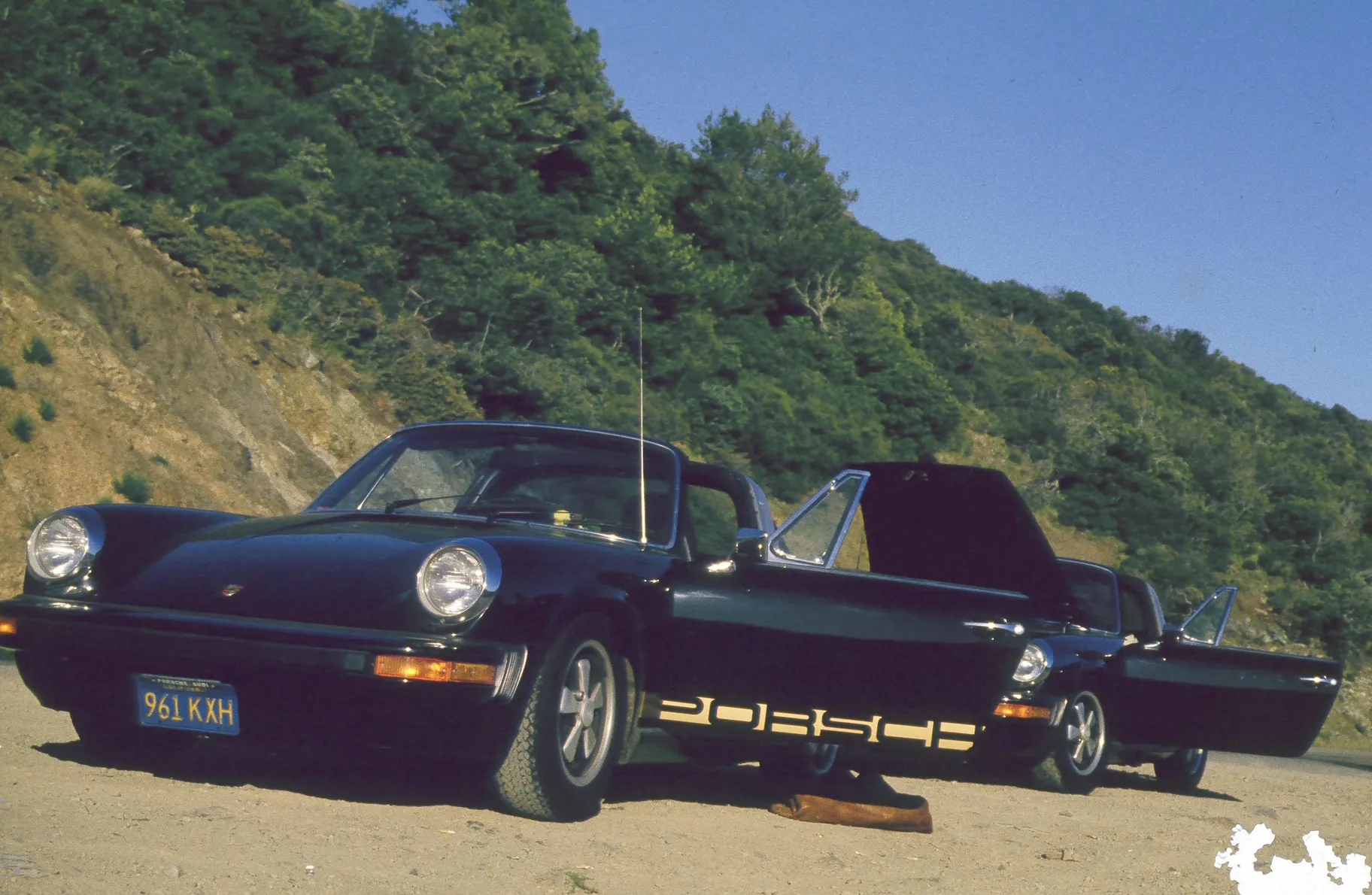
The Mizell brothers’ matching Porsche 911S convertibles. (Courtesy of Larry Mizell)
Novena Carmel
The location of their home was perfect in more practical ways, too. It was just a short drive down the canyon to all the recording studios in Hollywood. They'd make home demos on their four-track tape machine, recording all the parts themselves. And they’d take those demos down to the recording studio to play for the musicians. For their charts and sheet music, the Mizells contracted with a company called the Bob Ross Music Service (...not that Bob Ross), who would pick up the hand-written notes from their mailbox at 6 or 7 in the morning and turn around sheet music in time for the sessions to start at 11 AM.
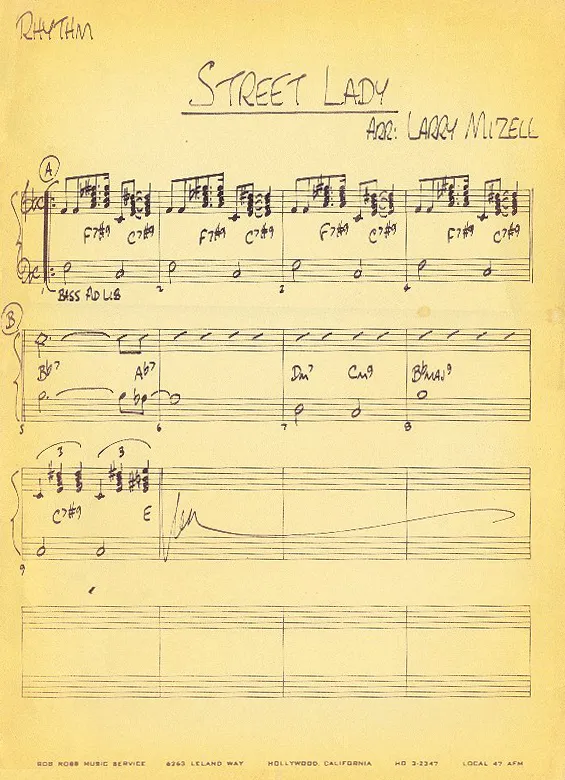
Handwritten chart for Donald Byrd’s “Street Lady” by Larry Mizell, with Bob Ross Music Service footer. (Courtesy of Larry Mizell)
Michael Barnes
For the recording of Black Byrd, the Mizells put together something like a house band, not dissimilar to LA's famous Wrecking Crew, featuring Wilton Felder & Joe Sample of the Crusaders, as well as musicians who would feature on multiple Mizell productions in the future, such as Harvey Mason, Chuck Rainey, King Errison, Roger Glenn, and of course, their long-time friend Freddie Perren. These were players who could work in a jazz idiom, but who also had backgrounds in soul, funk, pop, and blues. And while the brothers had arrangements in mind – worked out from those cassettes and sheets of music – they also trusted their players to work as a unit. They encouraged the musicians to find pockets of creativity, and to explore the vibe of the music together. As a result, the sessions took on a family atmosphere, with jams that would extend until the final seconds before the tape ran out. But once the songs found their shape, they called Byrd out from New York to work out his parts.
Donald Byrd, “Slop Jar Blues”
Michael Barnes
The Mizells' demos themselves were hugely important for conveying the feel of what they wanted. And this may be one reason why those Mizells records always felt like they came from the same musical universe, even when the headline artists were different. They wrote their tunes for themselves first and foremost, and never built their sound around somebody else’s ideas. Those classic records came directly out of their experience of living and vibing with one another up in the hills.
Novena Carmel
Equally important to the arrangements was the sound of the records themselves. And for that, the Mizells landed in the perfect studio to help them put their ideas on tape. The Sound Factory was located at 6357 Selma Avenue. It was owned by Dave Hassinger - who was Motown’s house engineer in Los Angeles until they could finish building their own MoWest Studios. Hassinger had a staff engineer named Val Garay, who had been working with Fonce on projects at the Sound Factory since the early days of the Corporation. With all of these connections, the Sound Factory became part of that same family atmosphere that imprinted itself on their most iconic productions.
Michael Barnes
The Sound Factory also had an incredible array of gear, some of which became the bedrock of the classic Mizell Brothers sound. This included the Fender Rhodes piano; the Hohner Clavinet D6; the Minimoog; and a pair of ARP synthesizers, the Odyssey and the Solina String Ensemble. The Solina in particular was making a splash as a way for producers to replicate the sound of string sections, without having to deal with the time and expense of hiring one. At the end of the day, the sound it made was not a one-to-one match for a real string ensemble. But it had a distinctive and quirky sound which contributed to the unique texture of the Mizells’ productions.
Novena Carmel
According to Larry, there was considerable ambivalence at Blue Note initially about how this sound fit in with Donald Byrd’s previous work. At one point, he says they weren’t even sure the label wanted to release it. But the collaboration proved to be wildly successful on almost every front -- musically, creatively, and especially commercially. Black Byrd became Blue Note's greatest-selling release of all time up to that point. It sold over 100,000 copies within the first six weeks. The album made it to #2 on the jazz charts, and the title track became a breakout single, cracking the R&B Top 20 and even the Hot 100 pop chart. It served as a vindication of the brothers’ confidence, imagination, and mastery in the studio.
Donald Byrd, “Black Byrd” (Live at Montreux, 1973)
Michael Barnes
The success of “Black Byrd” led to further collaborations with Donald Byrd, and after its release, there was suddenly a long line of jazz artists, and their record labels, who were hungry for that same success. The Mizells went on to produce iconic albums for flute player Bobbi Humphrey, organist Johnny “Hammond” Smith, and sax player Gary Bartz. And, while they kept a foot in the pop world with records by the Miracles, the Jackson Five, and Edwin Starr’s soundtrack to Hell Up In Harlem, 1973 to 1977 was an extraordinarily productive period of creation for the Mizells, producing no less than thirteen albums in that short period of time. And each and every one of them, began with ideas the brothers created in their Hollywood home: a true musical sanctuary.
Gary Bartz, “Music Is My Sanctuary”
Novena Carmel
But Byrd and the Mizells came up hard against the notoriously conservative jazz press, aka “the jazz police.” Mostly white and always male, they were not having Byrd's new direction. In the Calgary Herald, avant-garde musician Eugene Chadbourne fumed: "Who is Larry Mizell, and what does he know about Donald Byrd? Byrd, who has a Ph.D., by the way, has written material miles above Mizell's pap." Jeff Simon of the Buffalo Evening News said: "Byrd's hit formula (and formula it is) is to play a little update neo-bebop on top of a rock rhythm section and hope for the best." Downbeat Magazine -- as close to a paper of record as jazz ever had -- skipped out on even reviewing it altogether.
Michael Barnes
On and on throughout the 1970s, critics sharpened their knives every time a Mizell production came down the pike. But Larry says that neither he nor Fonce ever thought of what they were doing as jazz music, in the purists' sense. They sometimes called it "instrumental funk" when asked, but mostly, they just wanted to make music they were into. And thankfully, for those who fell in love with their music, fell in love to their music, played it at family gatherings and barbecues, danced to it in clubs or living rooms or at skating rinks, the Mizell Brothers just didn’t let what the critics had to say affect what they produced.
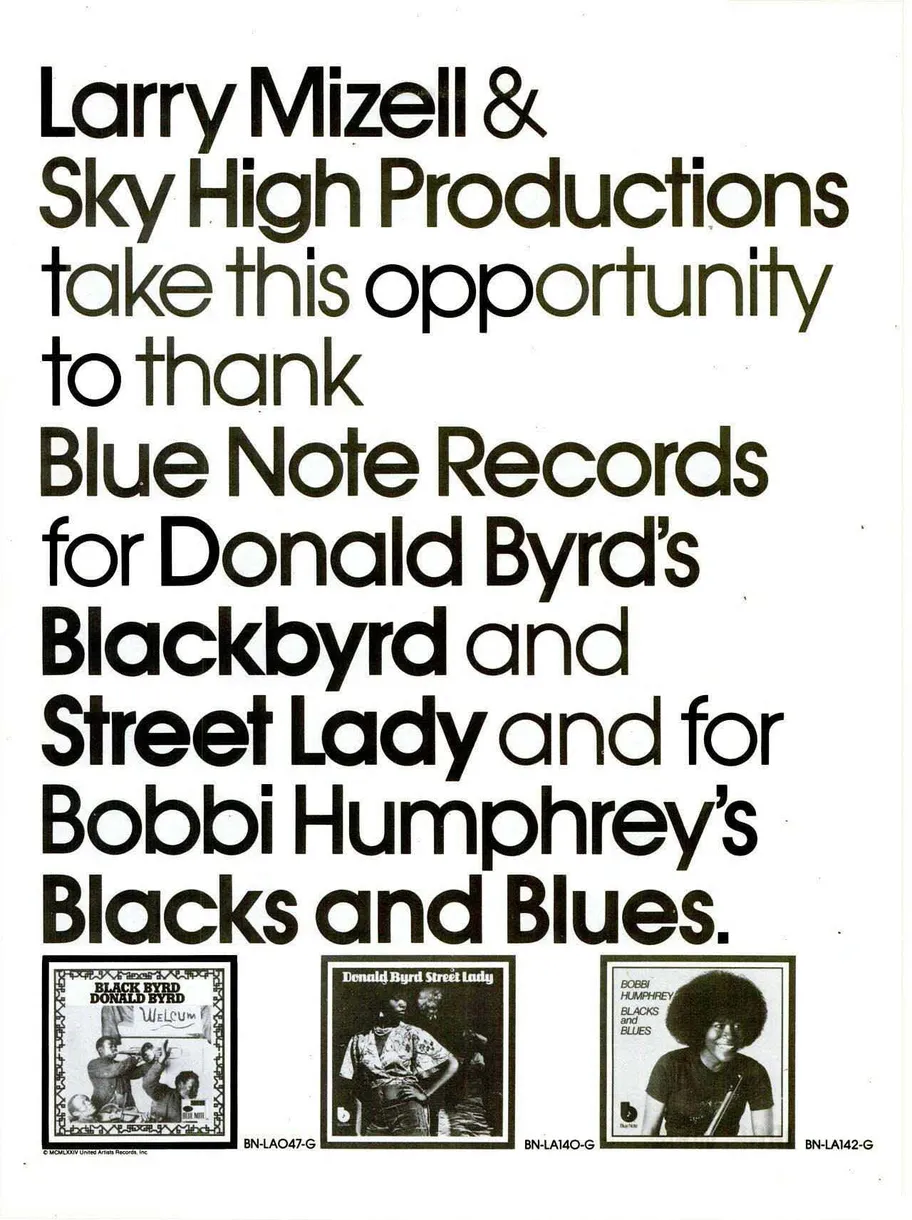
A print ad produced by the Mizells in 1974 highlighting their hit work for Blue Note Records. (Courtesy of Larry Mizell)
Novena Carmel
In 1976, Larry and Fonce’s 19-year-old brother, Rodney, joined them in LA. And he immediately became part of those family jam sessions up on the hill. He also jumped headfirst into their commercial work. He co-wrote three songs on the brothers’ final collaboration with Donald Byrd, Caricatures. And when the Mizells began working with a ten-piece soul outfit called L.T.D., Rodney co-wrote half the songs on their breakout album, Love to the World.
L.T.D., “Love To The World”
Michael Barnes
After all the success they’d achieved with their signature sound, the making of the L.T.D. album became a greater fiasco than the Mizells were ever used to. First of all, after two unsuccessful albums, L.T.D. was already deeply in debt to their label, A&M Records. So the label hired the Mizells in a last-ditch effort to turn the group’s fortunes around. And L.T.D.’s lead singer, Billy Osborne, just could not shake his resentment over that arrangement. And as for the Mizells, they most definitely were not used to working with such a large group of musicians from outside the family, so to speak.
Novena Carmel
The dam finally broke when the Mizells presented the group with “Love Ballad,” a song written by one of their associates, Skip Scarborough. Billy hated the song and stormed out of the studio in a huff, leaving his brother Jeff behind. Jeff was technically the drummer, but the Mizells went ahead and stuck him behind the mic – and he ended up giving the band its first hit. “Love Ballad” went to #1 on the R&B charts, and cracked the Top 20 in the pop charts as well. And on the basis of this reception, Jeffrey Osborne was crowned as L.T.D.’s new lead singer, and he went on to become one of the 1980s’ great R&B vocalists.
L.T.D., “Love Ballad”
Michael Barnes
Meanwhile, the Mizells’ old pal Freddie Perren was also making waves on the disco scene. He left Motown in 1975 and moved over to Capitol Records, where a Howard alum named Larkin Arnold had set him up as a producer. Almost immediately, he started racking up hits for The Miracles, The Sylvers, and Tavares, as well as doing the soundtrack for the much-cherished film, Cooley High. Perren also co-wrote two massive hits for Peaches & Herb, “Reunited” and “Shake Your Groove Thing.” And he earned two back-to-back Grammys: in 1978 for the Saturday Night Fever soundtrack, and in 1979 for Gloria Gaynor’s “I Will Survive.”
Novena Carmel
The Mizells themselves repeated their own hit-making magic in the producers’ chair for the group A Taste of Honey, whose 1978 disco classic, "Boogie Oogie Oogie" is still inescapable today.
A Taste of Honey, “Boogie Oogie Oogie”
Michael Barnes
And by this point, critics be damned, the Mizells had demonstrated their hit-making capabilities across multiple genres for years. So, in 1979, Warner Bros.’ Bob Krasnow invited the brothers to make their debut as recording artists in their own right under their own name. They began work on a project which was to be called, simply, The Mizells. Early previews of the album were received enthusiastically by the label, who then started tossing around big ideas, including a major headlining national tour.
Novena Carmel
But the brothers still maintained that the studio was their home; they wanted to keep on writing and producing behind the scenes, as they always had been. So, as work on the album continued to take a back seat to other projects, it became clear that they just weren't that into the idea. They arrived at an impasse with Warner Bros., who ultimately shelved the whole thing.
Michael Barnes
While the album has never been officially released, test pressings of the album have occasionally shown up online fetching hefty sums. And two of its tracks, just from their titles, seem to suggest that their relationship with the industry at large was beginning to change. First, there’s “Sometimes I Want To Be Alone," which Larry says was precisely about shutting out the noise of the world and being left to write and play. And also a song called “Too Close to Hollywood,” which seems to give a sense of how the Mizell Brothers truly were feeling as the 1970s came to a close.
The Mizells, “Too Close To Hollywood”
Novena Carmel
After 1980, there is only one more new credit to their name, a 1981 single by former Motown superstar Mary Wells called "Gigolo." And, in the midst of Thriller-mania in 1984, Motown suddenly discovered a "lost" Michael Jackson track produced by the Mizells from 1973 called "Farewell My Summer Love."
Michael Barnes
But perhaps the brothers felt they’d already done everything they set out to accomplish. And life was moving along: by 1984, both Larry and Fonce had turned 40. Larry’s son, Larry, Jr., was nearly ten. And the brothers wanted to bring their aging parents out to California so they could enjoy something of the life they’d built there. So, in October of 1984, they sold their storied home in the hills and moved the family out to Altadena, far away from Hollywood.
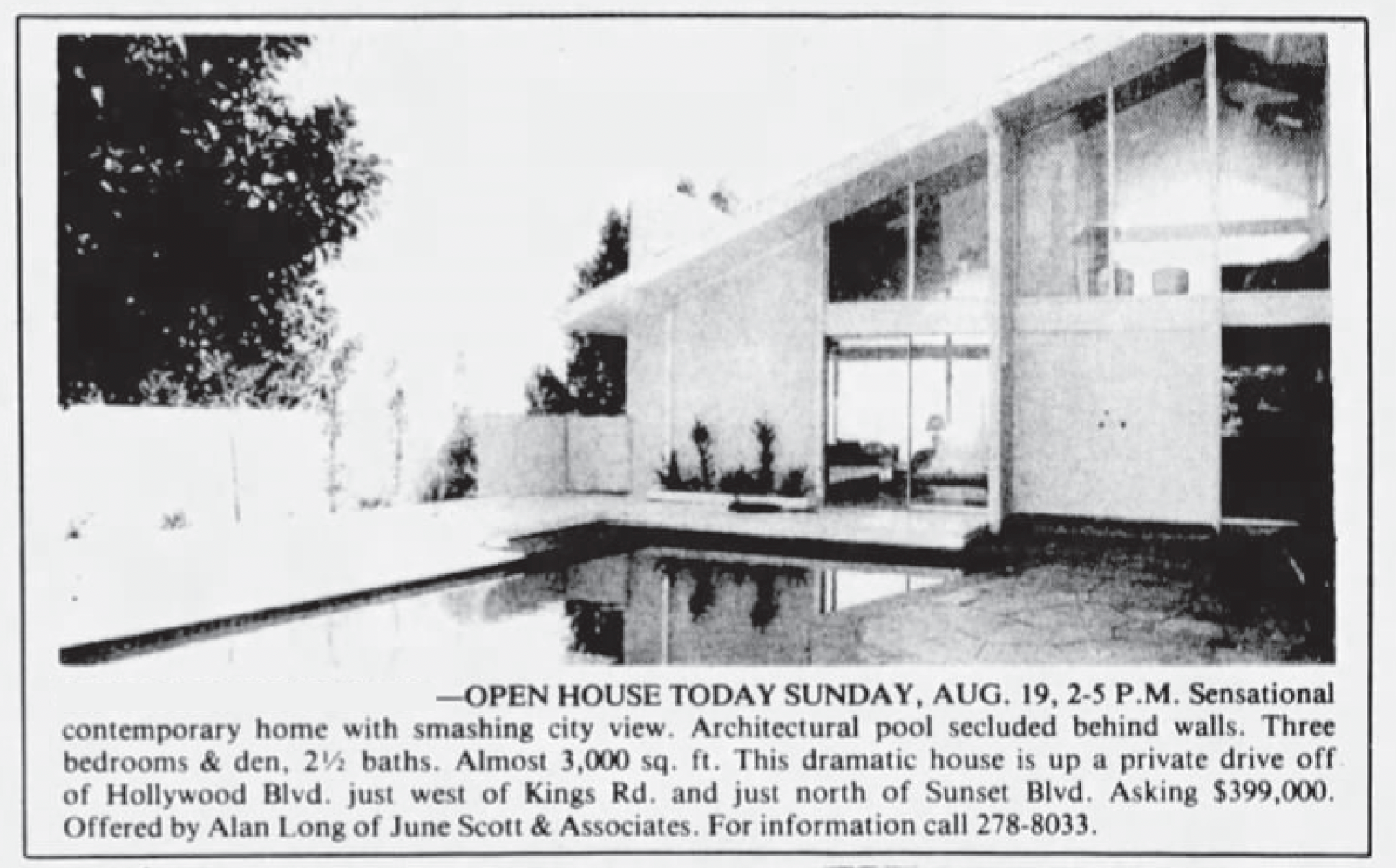
Real estate listing for the Mizell brothers’ Hollywood home in 1984.
Novena Carmel
But, as these things go, the Mizells' story was far from over. In the late 1980s, a new genre called "acid jazz" was bubbling up out of the UK, which took strong inspiration from the Mizells' work and translated it into a contemporary electronic sound. And you can clearly hear the influence of the Mizell’s in songs from groups like United Future Organization, Marden Hill, and Jamiroquai.
Jamiroquai, “When You Gonna Learn”
Novena Carmel
The advent of sampling meant that their work would be continually rediscovered by a new generation. Bites from the Mizells' tracks showed up all over golden era hip-hop in the 1990s, including records by the Jungle Brothers, A Tribe Called Quest, Public Enemy, Main Source, Eric B and Rakim, Ludacris, Digable Planets, and Ice-T.
Michael Barnes
Additionally, more than a few Neo-Soul artists also clearly loved the Mizell Brothers’ work, particularly Erykah Badu, whose album Mama’s Gun, produced by the Soulquarians crew, borrowed heavily from their work with Johnny Hammond, not once, but twice, both uncredited – which still perplexes Larry to this day. The track “Booty” lifts the tune “Gambler’s Life” more or less wholesale for its rhythm. And the song “Time’s A Wastin’” clearly samples “Can’t We Smile” from the album Gears. Now, I know it was all love, but … like I tell my students, “Cite your sources!”
Erykah Badu, “Time’s A Wastin’”
Johnny Hammond, “Can’t We Smile”
Michael Barnes
The love for the Mizell Brothers’ sound continues on into the 21st century, with samples by Madlib, Kendrick Lamar, and Tyler, The Creator. There were even rumors of a new Madlib collaboration with the Mizells in the mid-2000s, but it never came to fruition. Larry’s last released track, at least at this moment, is “Play with the Changes”, a collaboration with electronic duo 4Hero from 2006.
4Hero feat. Larry Mizell, “Play With The Changes”
Novena Carmel
Even if all this latter-day rediscovery had never happened, the Mizells’ place in history was already secure. Larry Mizell's scientific research had literally made it to the distant reaches of outer space. And his brother Fonce had touched eternity as part of the Corporation, and their immortal work for the Jackson Five. But there is a highly specific, and highly local, magic to the music they made together. And to many, it will always represent the sound of Los Angeles in the 1970s.
Michael Barnes
Absolutely. And as we close up this story, we want you to consider the title track of Donald Byrd's "Places and Spaces," and try to imagine all the things that title conjures: their youth spent in Harlem & Jersey; their time at Howard University; coming to Los Angeles and working with Motown; all the music they created here, and especially that house nestled in the Hollywood Hills, with that large bedroom, packed with musical instruments, overlooking a city still in the prime of its legend. And out in the driveway, two black Porsches, one for each brother to hug the curves of Hollywood Boulevard, collecting all the stardust shedding off of the streetlights.
Novena Carmel
And the dream of a perfect sound, rich with texture and lush with melody, cascading down the canyon into the master control booth at the Sound Factory. In the golden era of Larry and Fonce Mizell, from 1972 to 1979, there was no better dream in town.
Michael Barnes
Amen.
Donald Byrd, “Places & Spaces”
FURTHER READING BY LARRY MIZELL:
Larry Mizell, “Liquid Crystals: A New Technique for Thermal Mapping of Electronic Components.” 1971. [PDF]
Larry Mizell and Edward Keonjian, “Establishing an Electrical Test Philosophy for LSI Microcircuits, Vol. I,” 1971. [PDF]
Larry Mizell and Edward Keonjian, “Establishing an Electrical Test Philosophy for LSI Microcircuits, Vol. II,” 1971. [PDF]
Lost Notes is a KCRW Original Production. It’s made by Michael Barnes, Ashlea Brown, Novena Carmel, Melissa Dueñas, and Myke Dodge Weiskopf. Special thanks to Gina Delvac, Jennifer Ferro, Ray Guarna, Nathalie Hill, Anne Litt, Sue Margulies, Arnie Seipel, Desmond Taylor, and Anthony Valadez.
Extra special thanks this week to Eothen Alapatt of Now-Again Records, Jeff Chang, Val Garay, Andrew Lojero, Ali Shaheed Muhammad and Adrian Younge of Jazz Is Dead, Derek and Chris Perren of Freddie Perren Beats and Grooves Inc., Torsten Schmidt, Oliver Wang, and Dan Weiskopf.
Extra-extra special thanks to Larry Mizell for generously sharing his time, memories, and photos with us, and for making it possible to tell this story.
This episode is dedicated to the memory of Fonce Mizell, Rodney Mizell, Freddie Perren, and Matthew Africa.
MORE:
Lost Notes S4 - Ep. 4: Viva Tirado: The South/East LA Connection
Lost Notes S4 - Ep. 3: My Lady’s Frustration: How Fela Kuti Found Afrobeat in LA
Lost Notes S4 - Ep. 2: Mojo on Trial: The Seedy, Greedy World of Ruth Christie
Lost Notes S4 - Ep. 1 - Tainted Love: Gloria Jones and the Half-Life of a Hit
Lost Notes: 1980 - Ep. 6: Minnie Riperton
